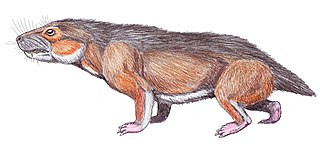
Therapsida is a clade composing of a major group of eupelycosaurian synapsids that includes mammals and their ancestors and close relatives. Many of the traits today seen as unique to mammals had their origin within early therapsids, including limbs that were oriented more underneath the body, resulting in a more "standing" quadripedal posture, as opposed to the lower sprawling posture of many reptiles and amphibians.

Sphenacodontia is a stem-based clade of derived synapsids. It was defined by Amson and Laurin (2011) as "the largest clade that includes Haptodus baylei, Haptodus garnettensis and Sphenacodon ferox, but not Edaphosaurus pogonias". They first appear during the Late Pennsylvanian epoch. From the end of the Carboniferous to the end of the Permian, most of them remained large, with only some secondarily becoming small in size.

Biarmosuchia is an extinct clade of non-mammalian synapsids from the Permian. Biarmosuchians are the most basal group of the therapsids. They were moderately-sized, lightly built carnivores, intermediate in form between basal sphenacodont "pelycosaurs" and more advanced therapsids. Biarmosuchians were rare components of Permian ecosystems, and the majority of species belong to the clade Burnetiamorpha, which are characterized by elaborate cranial ornamentation.

Tetraceratops insignis is an extinct synapsid from the Early Permian that was formerly considered the earliest known representative of Therapsida, a group that includes mammals and their close extinct relatives. It is known from a single 90-millimetre-long (3.5 in) skull, discovered in Texas in 1908. According to a 2020 study, it should be classified as a primitive non-therapsid sphenacodont rather than a genuine basal therapsid.

Galechirus is an extinct genus of anomodont therapsids. It was about 30 cm (1 ft) long.

Anomocephalus is an extinct genus of primitive anomodonts and belongs to the clade Anomocephaloidea. The name is said to be derived from the Greek word anomos meaning lawless and cephalos meaning head. The proper word for head in Greek is however κεφαλή (kephalē). It is primitive in that it retains a complete set of teeth in both jaws, in contrast to its descendants, the dicynodonts, whose dentition is reduced to only a single pair of tusks, with their jaws covered by a horny beak similar to that of a modern tortoise. However, they are in no way closely related.

Eotitanosuchidae is an extinct family of biarmosuchian therapsids. The Eotitanosuchidae were large predatory therapsids of the Wordian epoch. It was once considered to belong to a separate infraorder of therapsids called Eotitanosuchia.

Biseridens is an extinct genus of anomodont therapsid, and one of the most basal anomodont genera known. Originally known from a partial skull misidentified as an eotitanosuchian in 1997, another well-preserved skull was found in the Qingtoushan Formation in the Qilian Mountains of Gansu, China, in 2009 that clarified its relationships to anomodonts, such as the dicynodonts.
Colobodectes is an extinct genus of dicynodont therapsid from the Tapinocephalus Assemblage Zone in the Abrahamskraal Formation, South Africa.
Cistecephaloides is an extinct genus of dicynodont therapsids of the Cistecephalus Assemblage Zone, Beaufort Group of South Africa.

Dimacrodon is an extinct genus of non-mammalian synapsid from the latest Early Permian San Angelo Formation of Texas. It is distinguished by toothless, possibly beaked jaw tips, large lower canines and a thin bony crest on top of its head. Previously thought to be an anomodont therapsid related to dicynodonts, it was later found to lack any diagnostic features of anomodonts or even therapsids and instead appears to be a 'pelycosaur'-grade synapsid of uncertain classification.
Eosyodon is a dubious genus of extinct non-mammalian synapsids from the Permian of Texas. Its type and only species is Eosyodon hudsoni. Though it was originally interpreted as an early therapsid, it is probably a member of Sphenacodontidae, the family of synapsids that includes Dimetrodon.

Glanosuchus is a genus of scylacosaurid therocephalian from the Late Permian of South Africa. The type species G. macrops was named by Robert Broom in 1904. Glanosuchus had a middle ear structure that was intermediate between that of early therapsids and mammals. Ridges in the nasal cavity of Glanosuchus suggest it had an at least partially endothermic metabolism similar to modern mammals.
Knoxosaurus is an extinct genus of non-mammalian synapsids containing the species Knoxosaurus niteckii that existed approximately 279.5 to 268 million years ago. It was named by American paleontologist Everett C. Olson in 1962 on the basis of fragmentary fossils from Middle Permian-age deposits in the San Angelo Formation of Texas in the United States. Olson placed Knoxosaurus in a new infraorder called Eotheriodontia, which he considered a transitional group between the more reptile-like "pelycosaurs" and the more mammal-like therapsids. Knoxosaurus and Olson's other eotheriodonts were later considered to be undiagnostic remains of basal synapsids, no more closely related to therapsids than are other pelycosaur-grade synapsids.
Zorillodontops is an extinct genus of therocephalian therapsids from the Early Triassic of South Africa.

Raranimus is an extinct genus of therapsids of the Middle Permian. It was described in 2009 from a partial skull found in 1998 from the Dashankou locality of the Qingtoushan Formation, outcropping in the Qilian Mountains of Gansu, China. The genus is the most basal known member of the clade Therapsida, to which the later Mammalia belong.
Olivierosuchus is an extinct genus of therocephalian therapsids. It is a member of the family Akidnognathidae. Fossils of Olivierosuchus have been found from the Early Triassic Lystrosaurus Assemblage Zone in South Africa. Unlike other akidnognathids such as Moschorhinus, it has a narrow snout and fewer postcanine teeth. As a distinguishing feature, Olivierosuchus also has a sharp ridge near the choana, an opening in the skull palate. Bumps and projections cover the pterygoid, a bone that forms part of the palate.

Eutheriodontia is a clade of therapsids which appear during the Middle Permian and which includes therocephalians and cynodonts, this latter group including mammals and related forms.

The Donguz Formation, Donguz Svita, or Donguz Rocks is a Middle Triassic geological formation that crops out on the right bank of Donguz River in Orenburg Oblast, Russia, across the settlement of Pervomaisky. The formation is equivalent to a biostratigraphic unit, the Donguz Gorizont. It is famous for its rich collection of the fossils of Middle Triassic tetrapods.
Gorgodon is an extinct genus of basal synapsids. The genus is monotypic, known only from the type species Gorgodon minutus from the Early Permian of the southwestern United States. The only known remains of Gorgodon are two fossils consisting of fragments of the skull. Gorgodon was described and named by paleontologist Everett C. Olson in 1962 from the San Angelo Formation in Knox County, Texas. Based on what is known of Gorgodon—the squamosal, quadrate, and pterygoid bones of the back of the skull, the maxilla and premaxilla bones that make up the front of the skull, and several teeth—Gorgodon had a relatively large temporal fenestra and a pair large, conical caniniform teeth at the front of the jaw. Other distinguishing features of Gorgodon include the fused connection between the quadrate and squamosal bones and a long transverse process of the pterygoid.


















